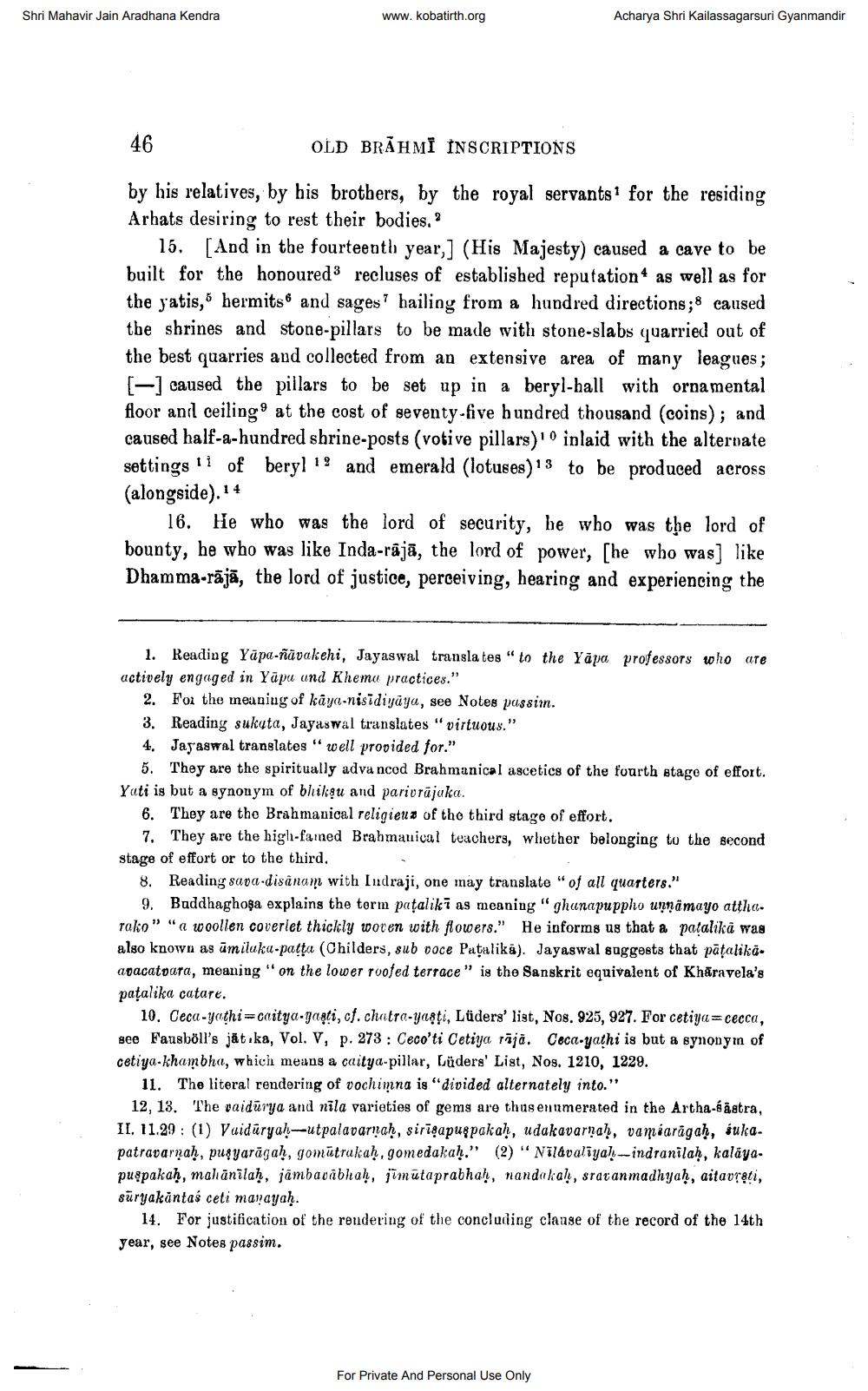________________
Shri Mahavir Jain Aradhana Kendra
www.kobatirth.org
Acharya Shri Kailassagarsuri Gyanmandir
46
OLD BRAHMI ÎNSCRIPTIONS
by his relatives, by his brothers, by the royal servants for the residing Arhats desiring to rest their bodies."
15. [And in the fourteenth year,] (His Majesty) caused a cave to be built for the honoured 3 recluses of established reputation as well as for the yatis, hermits and sages hailing from a hundred directions ;8 caused the shrines and stone-pillars to be made with stone-slabs quarried out of the best quarries and collected from an extensive area of many leagues; [-] caused the pillars to be set up in a beryl-hall with ornamental floor and ceiling at the cost of seventy-five hundred thousand (coins); and caused half-a-hundred shrine-posts (votive pillars) inlaid with the alternate settings 11 of beryl 1! and emerald (lotuses) 13 to be produced across (alongside).14
16. He who was the lord of security, he who was the lord of bounty, he who was like Inda-rājā, the lord of power, she who was] like Dhamma-rājā, the lord of justice, perceiving, hearing and experiencing the
1. Reading Yāpa-ñāvakehi, Jayaswal translates to the Yăpa professors who are actively engaged in Yūpu und Rhemu practices."
2. For the meaning of kāya-nisidiyāya, see Notes passim. 3. Readiny sukuta, Jayaswal translates "virtuous." 4. Jayaswal translates " well provided for."
5. They are the spiritually advanced Brahmanical ascetics of the fourth stage of effort. Yati is but a synonym of bhikṣu and parivrājuka.
6. They are the Brahmanical religieus of the third stage of effort.
7. They are the high-farned Brahmanical teachers, whether belonging to the second stage of effort or to the third.
8. Reading sava-disanam with Indraji, one may translate" of all quarters."
9. Buddhaghoga explains the term pataliki as meaning "ghanapuppho unnāmayo attharako" "a woollen coveriet thickly woven with flowers." He informs us that a patalika was also known as ūmilaka-patta (Childers, sub ooce Patalika). Jayaswal suggests that pātalikā. aracatoara, meaning "on the lower roofed terrace" is the Sanskrit equivalent of Khāravela's patalika catare.
10. Ceca-yathi=caitya-ganti, cf. chatra-yaşti, Lüders' list, Nos. 925, 927. For cetiya=cecca, see Fausböll's jātika, Vol. V, p. 273 : Ceco'ti Cetiya rājā. Ceca-yathi is but a synonym of cetiya-khambha, which means a caitya-pillar, Lüders' List, Nos. 1210, 1229.
11. The literal rendering of vochimna is "divided alternately into." 12, 13. The vaidūrya and nila varieties of gems are thus enumerated in the Artha-bästra, II. 11.29 : (1) Vaiduryah-utpalavarnaḥ, sirūsapugpakah, udakavarnah, vamiarāgah, sukapatravarnah, pusyarāgah, gomätrakah, gomedakah." (2) "Nilavalīyah-indranilah, kalaya. puspakah, mahānilah, jambavábhah, jimutaprabhah, nandakal, sratanmadhyah, aitavrati, süryakantaś ceti marayaḥ.
14. For justification of the rendering of the concluding clause of the record of the 14th year, see Notes passim.
For Private And Personal Use Only




